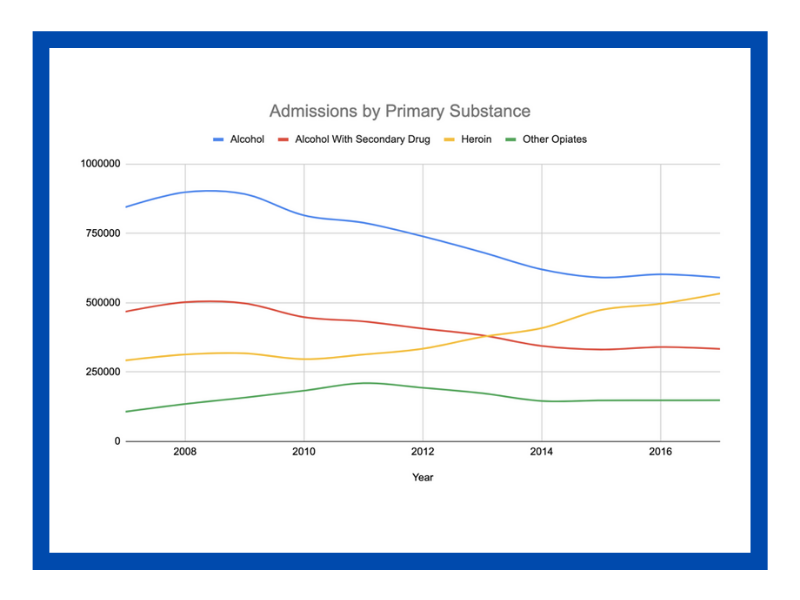Substance use among Americans is transitioning from one deadly drug to another.
Rates of Alcohol are Dropping and Heroin Use is Rising
In a recent analysis of data gathered by the Substance Abuse and Mental Health Services Administration (SAMHSA), the team at Find Recovery observed a worry-some pattern. The graph above shows the number of individuals admitted to a substance abuse program for use of alcohol, heroin, other opiates, and alcohol with a secondary substance. Between 2007 and 2017, it is clearly observed that the rates at which Americans use Alcohol alone and with other substances have been declining. This decline would be more exciting if it was not also met with an equally significant rise in Heroin use.
When observing this data, the first question that comes to mind is “Why? Why this shift from one dangerous substance to another.?” It did not take long for our team to make a connection between this data and a few major shifts already commonly known.
Prescription Opioids: Why Heroin Use Is On the Rise
The presence of heroin has been increasing for decades, with an increase observed since back in 1999. Yet, heroin and other opioid addiction did not start to rise significantly until about 2007. “What changed?” you might ask. Well, prescription opioids became the drug of choice for physicians across the country when patients came to them in pain and looking for relief. These prescription substances included oxycodone (OxyContin®), hydrocodone (Vicodin®), codeine, morphine, and synthetic opioids such as tramadol and fentanyl. The problem with these drugs that they are highly addictive, but people trusted it because they were prescribed by their doctor.
Heroin: A Dangerously Cost-Effective High
As millions of Americans became physically dependant and undoubtedly addicted to these prescription opioid drugs, their tolerance grew and their bank accounts were drained. It didn’t take long before American’s addicted to prescription opioids switched to a cheaper, stronger, and easier to obtain alternative: heroin.
The reality is that a drug dealer is significantly more likely to sell a fix of heroin to anyone with the money than a doctor is going to be to refill your prescription bottle for the 5th time this month. A substance that is 2 to 5 times stronger than morphine and potentially cheaper than prescription pain killers, heroin is an easy choice for anyone dealing with cravings.
A New Awareness of the Dangers of Alcohol Use
With an understanding of why heroin use is rising, the next question is why is alcohol use declining? One possible reason is due to an increased awareness of the dangers of alcohol use.
A 2011 publication on PubMed.gov explored a bold claim that “alcohol is more dangerous than heroin” and this was just one of the many scholarly articles published on the risks and dangers of alcohol. Another article published by the Royal College of Physicians was titled “Is it time to ban alcohol advertising?” It seems that western society has caught on to the dangers of alcohol consumption. Studies are showing the truth, professionals as talking about it, and people are listening.
What is interesting is that the numbers show a decline in alcohol use with a second drug. This points to the fact that even individuals who use other substances such as heroin or other opiates are declining in their rates of alcohol use. Do these individuals not understand the dangers of opioid use? Perhaps they don’t, but perhaps the issue is something else.
Another event that may have sparked the decrease in individuals seeking help for alcohol addiction is the introduction of Vivitrol (Naltrexone), an opioid antagonist administered once-monthly for the treatment of alcohol dependence. In 2006, this drug was approved to be administered to treat alcohol dependence. Things began to level off and in the years following the approval, and decreased shortly after.
Questions We Still Have
There are still a lot of questions. For instance, these numbers do not include individuals who are struggling with drug and alcohol addiction. How would those numbers affect the data? What can be done to help bring down overall addiction numbers? What should we expect in the coming years? Only time will tell. For the time being, we do what we know, education, early detection, and treatment.
